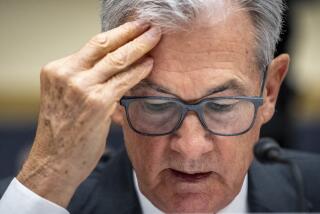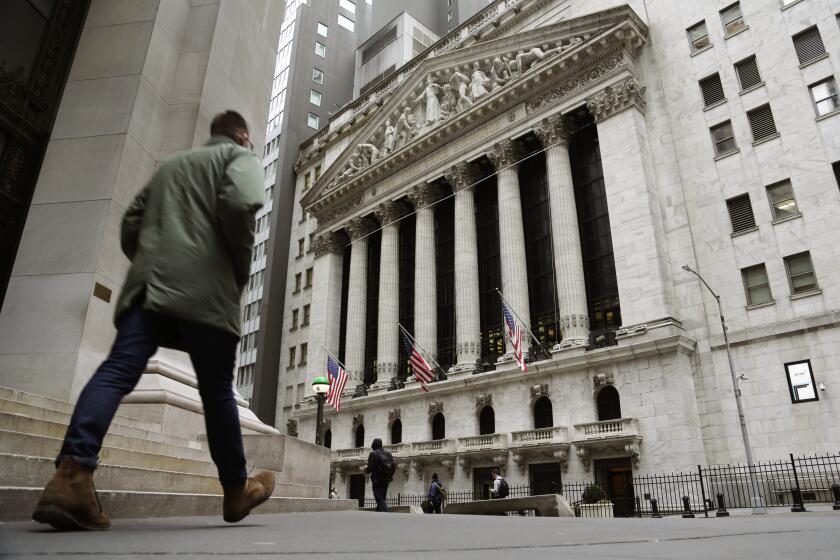Prime Rate Cut by Major Banks : Economy: The half-point reduction to 8.5% is hailed by the President. But economists are divided on how effective the move will be in ending the recession.
- Share via
WASHINGTON — The nation’s major banks cut their prime lending rates Wednesday in the wake of Tuesday’s action by the Federal Reserve to reduce its own charges to banks, but it was not immediately clear whether the move would be enough to jolt the economy out of the recession.
The reduction in the prime interest rate--to 8.5% from 9%--was led by Morgan Guaranty Bank of New York and was quickly followed by a spate of large banks, from First National Bank of Chicago to Citibank, the nation’s largest.
A change in the prime rate--the interest that banks charge their most credit-worthy corporate customers--traditionally sets the pattern for a wide range of other interest rates, from consumer loans to mortgage lending.
President Bush, who had actively sought a reduction in interest rates, hailed the banks’ move as a tonic that might cure the recession.
“I think that’s going to be very good for the United States of America,” an enthusiastic Bush told the American Society of Business Editors and Reporters. “I think we’re going to be coming out of the recession, particularly with this drop in interest rates.”
But economists were divided on how effective the new rate-cut would be. A. Gary Shilling, a Wall Street economist, said the impact might be blunted by the fact that many banks are still nervous about their big portfolios of bad loans and would continue to be wary of lending much.
“There is a tremendous” reluctance to lend, particularly in real estate, Shilling said. “When bankers are so scared” and federal regulators are being unusually tough, he said, “it does not make much difference what the interest rate is.”
The move came as, separately, the government published new figures suggesting that the economy may be on the verge of a rebound.
The Commerce Department said its index of leading indicators, a closely watched but somewhat uncertain guide to future economic performance, rose 0.5% during March after a gain of 1.2% in February.
But economists cautioned that much of the latest rise stemmed from an improvement in stock prices, one of 11 separate components in the index, and is not necessarily related to a real improvement in the economy. They warned that the index often emits signals prematurely.
Meanwhile, the Commerce Department reported that construction spending dipped last month, with across-the-board declines in outlays for single-family homes, office buildings, shopping centers and government projects.
And a survey of the nation’s purchasing managers showed them somewhat more optimistic about the economy during April, but continued to show that the recession remains. New orders and production at the companies slipped again last month, the report said.
However, the surveyed managers were slightly more optimistic in April than in March because they were paying less for raw materials and because the inventories of goods on warehouse shelves dropped sharply.
The overall portrait painted by the various economic reports issued Wednesday is one of an economy that is still weakening but slowing its decline and possibly nearing the bottom of the recessionary cycle.
On Tuesday, the Fed cut the discount rate--the interest it charges on loans to member banks--contending that the recession was lingering longer than expected.
Wednesday’s reduction in the prime pushed that key lending rate to its lowest level since March, 1988.
The prime rate cut provided welcome news. “The banks’ action is like a tax cut,” said Lawrence Kudlow, director of research at Bear, Stearns & Co., a brokerage firm. “I think it’s a big plus. The Fed has cut interest rates, and banks have passed it to businesses and consumers.”
In the past three years, rising interest “has been the single most negative factor (hurting) business profits,” Kudlow said.
A lower prime “translates into lower interest expenses and opens the outlook for better profits over the course of the year,” and the nation “will not have a sustainable economic recovery or expansion of jobs and capital spending until profits turn up,” he said.
The Bush Administration is fearful that, despite lower rates, bankers still may be skittish about granting new loans. Michael J. Boskin, chairman of the President’s Council of Economic Advisers, repeated the Administration’s exhortations to bankers to loosen up and to regulators to show understanding.
“We certainly believe the availability of credit is still a concern, and we want to make sure regulators and others are doing things properly and don’t make credit less available than it should be,” Boskin said at the business editors and writers meeting.
The Administration, which previously said the recession would end in March, is now predicting a recovery sometime in the second half of the year.
DROP IN PRIME RATE
The prime rate is the rate banks historically charge their best customers. Chart shows general industry rate.
1986: 9.5% 1989: 11.5% May 1991: 8.5%
More to Read
Inside the business of entertainment
The Wide Shot brings you news, analysis and insights on everything from streaming wars to production — and what it all means for the future.
You may occasionally receive promotional content from the Los Angeles Times.










